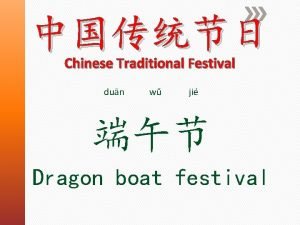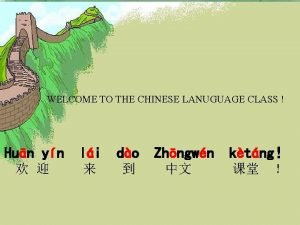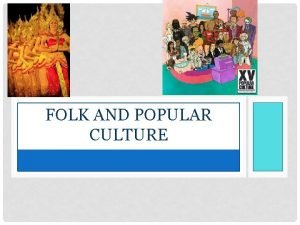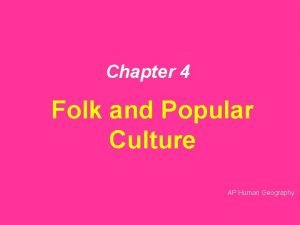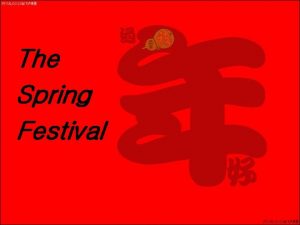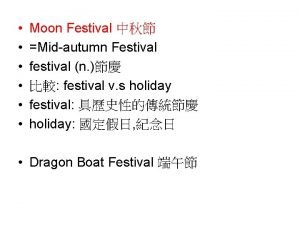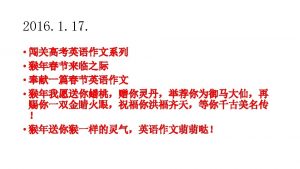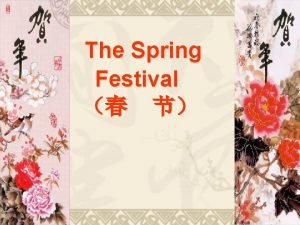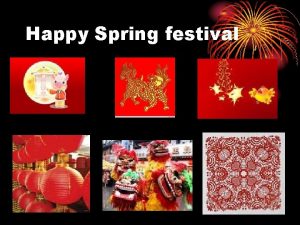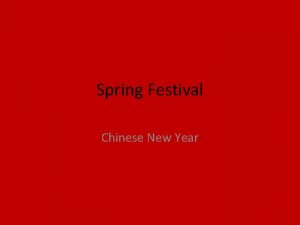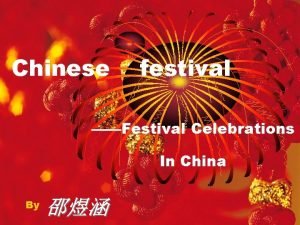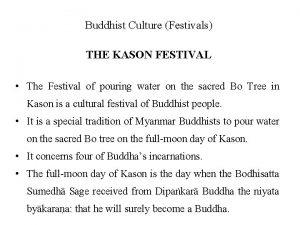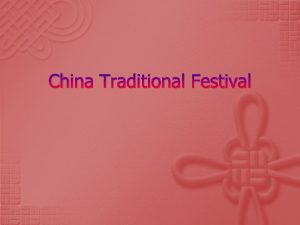Chinese culture Spring Festival The Origin of Chinese




















- Slides: 20








中国文化 Chinese culture

中国的春节 Spring Festival

春节的由来(The Origin of Chinese New Year ) 春节的由来( � The Chinese New Year is now popularly known as the Spring Festival because it starts from the Beginning of Spring. Its origin is too old to be traced. that the word Nian, which in modern Chinese solely means "year", was originally the name of a monster beast that started to prey on people the night before the beginning of a new year. the tradition of observing the conquest of Nian is carried on from generation to generation. The term "Guo Nian", which may mean "Survive the Nian" becomes today "Celebrate the (New) Year" as the word "guo" in Chinese having both the meaning of "pass-over" and "observe". The custom of putting up red paper and firing fire-crackers to scare away Nian should it have a chance to run loose is still around. However, people today have long forgotten why they are doing all this, except that they feel the color and the sound add to the excitement of the celebration.


放鞭炮,贴春联 Firework Spring Festival Scrolls

逛庙会 Temple Fair in China !

五十六个民族的大家庭 China has fifty-six ethnic groups.

四大发明( four inventions )

火药(Gunpowder) � Gunpowder China. is one of the four inventions of In Chinese, gunpowder is called huo yao, meaning flaming medicine. Unlike paper and printing, the birth of gunpowder was quite accidental. It was first invented inadvertently by alchemists while attempting to make an elixir of immorality. It was a mixture of sulphur, saltpeter, and charcoal. At the end of the Tang Dynasty, gunpowder was being used in military affairs. During the Song and Yuan Dynasties, frequent wars spurred the development of cannons, and fire-arrows shot from bamboo tubes.

指南针(Compass) � During the Warring States period, a device called a Si Nan became the forerunner of the compass. A Si Nan was a ladle-like magnet on a plate with the handle of the ladle pointing to the south. In the 11 th century, tiny needles made of magnetized steel were invented. One end of the needle points north while the other points south. The compass was thus created. The compass greatly improved a ship's ability to navigate over long distances. It was not until the beginning of the 14 th century that compass was introduced to Europe from China.

印刷术(Printing) � During the reign of Emperor Ren Zong of the Northern Song Dynasty, Bi Sheng invented moveable, reusable clay type after numerous tests. Single types were made and picked out for printing certain books. These types could be used again and again for different books. Because of the large number of different characters in the Chinese written language, this technique did not have a dramatic impact at the time. However, today, this typesetting technique is regarded as a revolution in the industry. About 200 years later, this moveable-type technique spread to other countries and advanced the development of world civilization.

造纸术(Papermaking Technology) � In 105 A. D. Cai Lun, a eunuch during the Eastern Han Dynasty, invented paper from worn fishnet, bark and cloth. These raw materials could be easily found at a much lower cost so large quantities of paper could be produced.

 Chinese festival estonia
Chinese festival estonia Chinese traditional festival
Chinese traditional festival Chinese festival
Chinese festival Kim ki duk summer fall winter spring
Kim ki duk summer fall winter spring Summer spring autumn winter
Summer spring autumn winter Primary 3 malay worksheets
Primary 3 malay worksheets Pop culture origin
Pop culture origin Folk culture definition ap human geography
Folk culture definition ap human geography Vce chinese language culture and society
Vce chinese language culture and society East asia spice t chart
East asia spice t chart Stab culture and stroke culture
Stab culture and stroke culture Batch culture vs continuous culture
Batch culture vs continuous culture Carpet culture method
Carpet culture method Folk culture and popular culture venn diagram
Folk culture and popular culture venn diagram Homework due today
Homework due today Fed-batch
Fed-batch Laying the foundation for a quality culture
Laying the foundation for a quality culture Vocational subculture
Vocational subculture Material and non material culture examples
Material and non material culture examples In an inert organizational culture,
In an inert organizational culture, Indian vs american culture
Indian vs american culture

